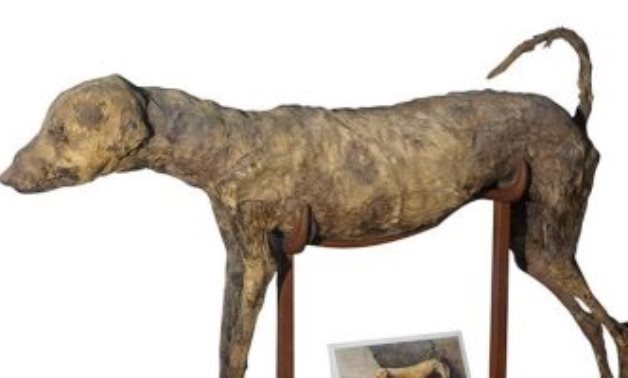Mummified hunting dog rests in Egyptian Museum in Tahrir

The mummified hunting dog – social media
CAIRO – 15 June 2022: The Egyptian Museum in Tahrir contains a large collection of artifacts. The museum displays some 50,000 unique artifacts.
Among these pieces is the mummy of a hunting dog, which clearly proves that the ancient Egyptians excelled in mummification, and reached a high degree of accuracy and craftsmanship.
 The hunting dog’s mummy is displayed in the Egyptian Museum in Tahrir, room No. 53. It was found in tomb KV 50 near the tomb of King Amenhotep II (18th Dynasty).
The hunting dog’s mummy is displayed in the Egyptian Museum in Tahrir, room No. 53. It was found in tomb KV 50 near the tomb of King Amenhotep II (18th Dynasty).
Located in the heart of Cairo, the Egyptian Museum in Tahrir houses the largest collection of ancient Egyptian antiquities, which comprises more than 136,000 Pharaonic antiquities. This is in addition to hundreds of thousands of antiquities in its stores.
On June 29, 1835, Mohammad Ali Pasha ordered the establishment of the Antiquities Department and the Egyptian Museum, and assigned their management to Youssef Dia Effendi, under the supervision of Refa’a al-Tahtawi.
The story of establishing the museum began with the great global interest in Egyptian antiquities after deciphering the Rosetta Stone at the hands of the French scientist Champollion. The first phase of the museum was a small house at the ancient Azbakeya Lake. Mohammad Ali Pasha ordered the registration of fixed Egyptian antiquities and the transfer of valuable antiquities to the Azbakeya Museum in 1835.
After the death of Mohammad Ali, antiquities theft returned again, and his successors followed the gifting approach, so the museum’s holdings dwindled, and in 1858, Mariette was appointed as the first commissioner of antiquities occupancy, which is currently corresponding to the head of the Antiquities Department.
Mariette found that an antiquities administration and museum must be founded, so he chose the Bulaq area to establish a museum of Egyptian antiquities and transfer to it the antiquities found during his excavations.
In 1863, Khedive Ismail approved the project to establish a museum of Egyptian antiquities, but the project was not implemented, instead he gave Mariette a place in front of the Anti-Khana House in Bulaq to expand his museum.
In 1878, there was a severe rise in the Nile flood, which resulted in the flooding of the Bulaq Museum, and the loss of some of its holdings. The museum reopened in 1881, and in the same year Mariette died and was succeeded by Maspero as director of antiquities and the museum.
In the year 1890, when the collections of the Bulaq Museum increased, they were transferred to the Giza Saray. When the scientist De Morgan came as head of the antiquities authority and the museum, he re-arranged these collections in the new museum, which was known as the Giza Museum. In the period from 1897-1899, Loret succeeded Morgan, but Maspero returned again to run the department and the museum from 1899 – 1914.
In 1902, Maspero transferred the antiquities to the current building of the Egyptian Museum in Tahrir Square. One of his most active assistants in this period was the Egyptian scientist Ahmed Pasha Kamal, who was the first to specialize in ancient Egyptian antiquities and worked for many years in the museum.
The first Egyptian director of the museum was Mahmoud Hamza, who was appointed in 1950. The museum had a brief guide written by Maspero dating back to 1883, but he made a large guide for the new museum, which has been printed and circulated from 1915 until now.
Related Post
A shocking documentary proves that mermaids do exist
SHOCKING Revelation: Thuya, Mother of Queen Tiye, Was the Grandmother of Akhenaten and Tutankhamun—What Ancient Egyptian Secrets Did She Leave Behind?
Breaking News: Astonishing Discoveries at Karahan Tepe Confirm an Extraterrestrial Civilization is Hiding on Earth, and NO ONE Knows!
Breaking News: Researchers FINALLY Discover U.S. Navy Flight 19 After 75 Years Lost in the Bermuda Triangle!
NASA’s Secret Investigation: Uncovering the Astonishing Mystery of the UFO Crash on the Mountain!
Explosive UFO Docs LEAKED: Startling Proof That Aliens Ruled Ancient Egypt!